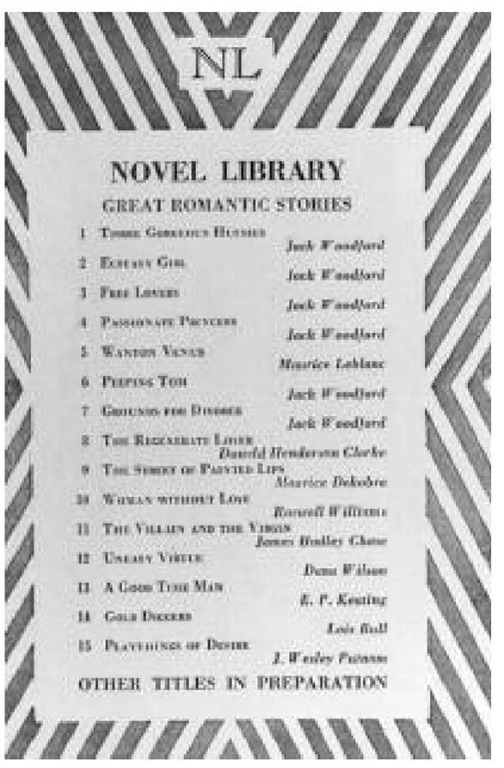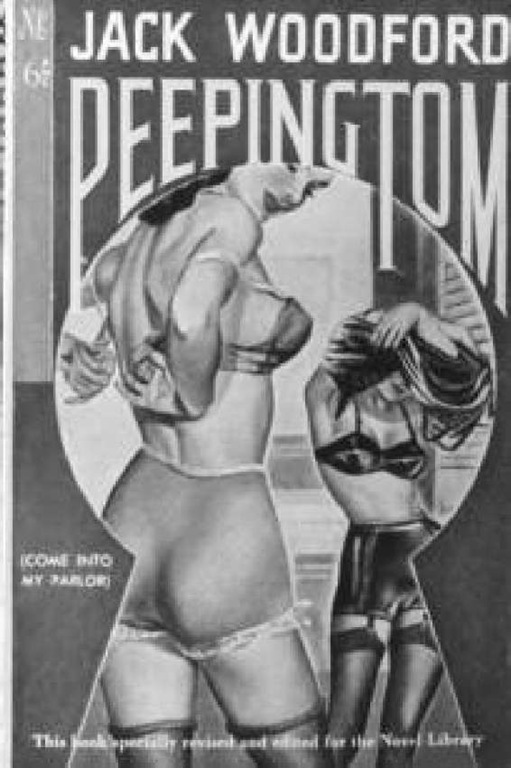(1894-1971) Also wrote as: Sappho Henderson Britt
Jack Woodford, to those willing to admit such knowledge, was once a brand name in the peculiar subgenre of popular literature whose goal was the reader’s erotic stimulation. In the lending libraries and bookstores of the 1930s and 1940s, a topic jacket with Woodford’s name on it—or one of his pseudonyms—guaranteed something a little more spirited than the average read. Under his various names, Woodford churned out dozens of mildly risque “modern” novels that touched on matters of unwed passion and sexual experimentation. In topics like Her First Sin, Unmoral, and Three Gorgeous Hussies, Woodford represented the new generation of depression-era, American erotica writers whose work was aimed not at the sophisticated connoisseurs of earlier years but at lower- and middle-class readers, male and female, who were willing to pay the 4-cent lending-library fee for some entertainment and escapism. Woodford’s tone was not sophisticated or decadent in the manner of the Edwardian erotica writers, but contemporary and wised-up about intimate matters between guys and dames. The readers, in any case, did not seem to demand more than a hint of naughty intentions. One could comb through some of Woodford’s supposedly sexy topics—and those of other lending-library sex-pulp authors—without finding anything even remotely juicy, and none of the topics were ever as exciting or explicit as their provocative titles or jackets. Nonetheless, Woodford’s novels were often banned by court edict and seized by police and vigilante groups who raided offending bookstores well into the 1960s, and people went to jail for selling his work.
In addition to his sex pulp novels, Woodford wrote several volumes of “how-to” topics on the art and craft of writing and getting published. These eminently readable and practical guides, such as Trial and Error, were considered bibles for a generation of would-be writers. In the ’40s, a publishing concern headed by Allen Wilson went into partner ship with Woodford to repackage the old erotica titles and some new ones. Flattering the author—and recognizing his marketability—the new firm was called Jack Woodford Press, and the topics sold well, especially to servicemen. Woodford then found a final burst of success in the new popular fiction venue of the mass-market paperback. Wood-ford Press sold paperback rights for numerous Woodford titles to Avon topics and other purveyors of softcover sensationalism. Once again, the topics were overhyped with racy new titles and voluptuous cover illustrations. Later in the ’50s, Woodford wrote original paperbacks for such “sleaze” developers as Beacon topics, usually in collaboration with young writers, among them John Thompson. The likelihood is that Woodford was merely attaching his still valuable name to these unknown writers’ manuscripts, perhaps giving them the benefit of his final edit. Always a volatile and unpredictable character, Woodford was a notorious writer of angry letters to officials and newsmakers, a rabid anti-Semite and paranoiac (briefly a Hollywood screenwriter in the 1920s, he was said to have been banned from the studios for his bigoted rants). When he shot a visiting postal investigator, he was sent to prison. His stature, such as it was, faded with the changing tastes of the swinging ’60s. According to Allen Wilson, he spent his last days in an insane asylum.
Advertisement for Novel Library editions, including several stories by Jack Woodford
The covers of Jack Woodford’s novels were usually more provocative than the stories themselves.
Works
- Abortive Hussy (1947);
- Assistant Wife (1935);
- Bundle of Curves (1952);
- Case for Passion (1953);
- City Limits (1932);
- Come into My Parlor (1936);
- Dangerous Love (1950);
- Delinquent (1934);
- Ecstasy Girl (1948);
- Ecstasy Girl (1948);
- Evangelical Cockroach (1930);
- Fiddler’s Fee (1934);
- Find the Motive (1932);
- Five Fatal Days (1933);
- Flame (1949);
- Frenzy (1953);
- Gentleman from Parnassus (1936);
- God’s Lap (1936);
- Hard-boiled Virgin (1947);
- Her First Sin (1944);
- Here Is My Body (1931);
- Honeymoon Delayed (1937);
- Hoof Hearted (1951);
- How to Make Your Friends and Murder Your Enemies (1981);
- How to Write for Money (1949);
- Illegitimate (1933);
- Indecent? (1934);
- Journey to Passion (1950);
- Lady Killer (1935);
- Lady Mislaid (1936);
- Leased (1954);
- Love at Last (1937);
- Love in Virginia (1935);
- Male and Female (1934);
- Masterful (1954);
- Mirage of Marriage (1935);
- Nikki (1953); Nymph’s Conquest (1953);
- Passionate Princess (1948);
- Poetry in Flesh (1952);
- Possessed (1935); Proxy Princess (1937);
- Rented Wife (1933);
- She Liked the Man: A Novel (1936);
- Sin and Such: An Unconventional Novel (1936); S
- incerely Yours (1951);
- Smouldering (1953);
- Softly Clay (1934);
- Starved (1953);
- Strangers in Love (1934);
- Surrender (1953);
- Tainted (1953);
- Three Gorgeous Hussies (1936; revised edition published 1948);
- Torrents (1951);
- Trial and Error (1933; revised edition published 1947);
- Two Can Play (1952); Unconventional (1952);
- Unleashed (1953); Unmoral (1933);
- Unwilling Sinner (1933);
- Vice Versa (1935);
- Web of Desire (1953);
- White Meat (1931);
- Why Write a Novel (1943);
- Wife to Trade (1936)
As Sappho Henderson Britt:
- Passion in the South (1935)
With John B. Thompson:
- Desire in New Orleans (1952);
- Hitch Hike Hussy (1956);
- Honey (1954);
- Male Virgin (1950);
- Savage Eve (1953);
- Sugar Doll (1956)
With Robert W. Tracy:
- Sinful Daughter (1951)
With Gordon Greene:
- Taboo (1953);
- Take Me (1953)


